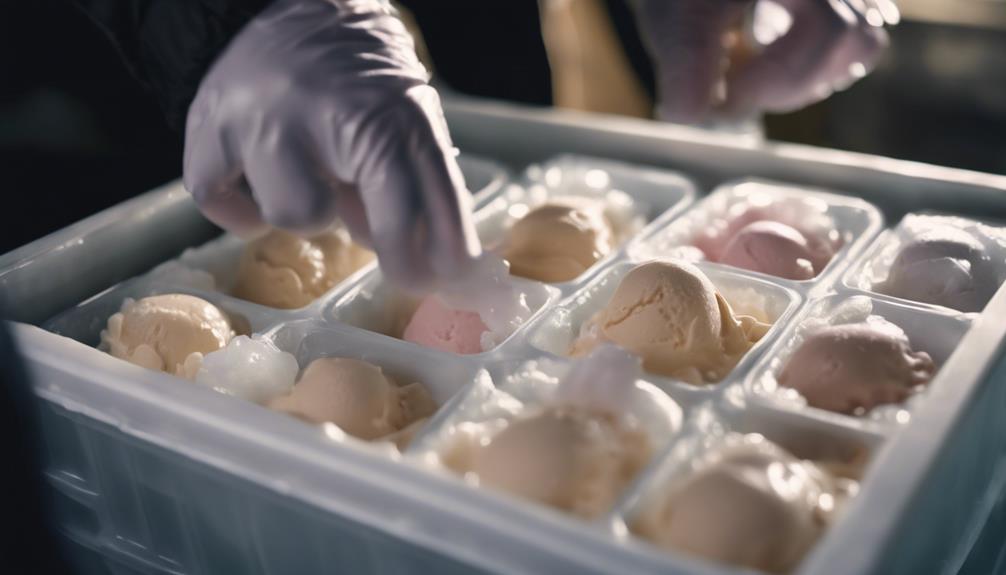Ensure your ice cream stays frozen during shipping by placing it in a well-insulated container and sealing it securely. Add an extra layer of protection with parchment paper or bubble wrap. Distribute cooling elements such as gel packs or dry ice evenly to maintain a consistent temperature. Choose expedited shipping with carriers that have experience handling perishable items. Clearly label packages as fragile and provide specific handling instructions. Consider the sensitivity of temperature and preserving the texture of the ice cream as crucial factors. Proper packaging and selecting the appropriate shipping service are essential for a successful delivery. Following these guidelines will help ensure your ice cream arrives in perfect condition and remains delicious.
Key Takeaways
- Pack ice cream in insulated containers with cooling elements.
- Use dry ice or gel packs for effective temperature control.
- Opt for expedited shipping to minimize melting risks.
- Label packages as fragile and perishable.
- Communicate clear handling instructions with the carrier.
Preparation and Packing Process

Prepare the ice cream for delivery by making sure it's thoroughly frozen and properly packed in an insulated container. For shipping ice cream, maintaining temperature control is vital. Consider using dry ice to keep the ice cream cold throughout the journey.
Before placing the ice cream in the container, layer it with parchment paper or bubble wrap to provide additional insulation against external heat. Seal the container tightly with plastic wrap or a secure lid to prevent any warm air from seeping in and causing melting.
It's recommended to place the ice cream and insulated container in the freezer overnight to make certain it remains frozen during delivery. Additionally, leave space in the container for cooling elements like dry ice or gel packs. Distribute these cooling elements evenly around the container to optimize temperature control and keep the ice cream from melting.
Following these steps will help protect your ice cream from heat exposure and guarantee it arrives in perfect condition.
Adding Cooling Elements

To maintain ideal temperature control during ice cream delivery, evenly distribute cooling elements like gel packs around the insulated container. Seal the container tightly to maximize the cooling effect of the gel packs. Additionally, consider adding foam inserts or packing peanuts for added insulation against temperature fluctuations. If possible, opt for a temperature-controlled shipping container to regulate the temperature more effectively during transit. Ensure there is enough space within the container for the cooling elements to work efficiently and keep the ice cream frozen.
| Cooling Elements | Benefits |
|---|---|
| Gel Packs | Even cooling distribution |
| Dry Ice | Intense cooling effect |
| Foam Inserts | Added insulation |
| Packing Peanuts | Prevents temperature changes |
Selecting Suitable Shipping Services

When selecting shipping services for your ice cream delivery, opt for carriers with experience handling perishable items and choose expedited shipping options to minimize melting risks.
Make certain to label the package as fragile and perishable, include clear handling instructions, and communicate with the recipient for a smooth delivery process.
Prioritize selecting appropriate shipping services to guarantee your ice cream arrives fresh and intact.
Shipping Carrier Selection
Consider selecting shipping carriers with expertise in handling perishable items like ice cream to guarantee the safe and timely delivery of your orders. To safeguard your ice cream arrives in perfect condition, follow these tips:
- Opt for carriers experienced in shipping perishable items: Look for carriers with a proven track record in handling temperature-sensitive products like ice cream.
- Label the package correctly: Clearly mark the package as perishable and fragile to alert carriers and handlers about the contents, prompting them to handle it with care.
- Include clear handling instructions: Provide specific instructions on the package on how to transport the ice cream safely, ensuring it stays frozen during transit.
- Communicate with the recipient: Keep the recipient informed about the delivery date and consider requiring a signature for added security during shipping.
Expedited Delivery Options
Select fast shipping services to ensure quick and efficient delivery of your ice cream orders.
When shipping perishable items like ice cream, it's essential to minimize transit time to maintain the proper temperature control and achieve the product reaches its destination in the best condition.
Opt for carriers experienced in handling perishable items, as they'll know how to prioritize the sensitivity of your package.
Label the package as perishable and fragile to alert carriers and handlers to handle it with care. Include clear handling instructions for carriers, emphasizing the importance of maintaining proper temperature control throughout the delivery process.
Communicate with the recipient about the delivery date to guarantee someone is available to receive the package promptly.
Additionally, requiring a signature upon delivery will confirm the safe receipt of the package and help maintain the quality of your ice cream during transit.
Handling Fragile Packages
To secure the safe delivery of your delicate ice cream packages, it's important to select shipping carriers experienced in handling perishable items. When dealing with fragile packages, follow these essential tips:
- Label Appropriately: Clearly mark the package as fragile and perishable to make sure careful handling during transit.
- Provide Handling Instructions: Include detailed handling instructions on the package, such as 'Handle with Care' or 'Keep Frozen,' to guide carriers.
- Consider Expedited Shipping: Choose expedited shipping options to reduce transit time and minimize the risk of melting.
- Communicate and Secure: Keep the recipient informed about the delivery date and require a signature for added security.
Challenges and Materials

Managing the challenges of ice cream's temperature sensitivity and texture preservation during shipping requires essential materials like insulated containers and dry ice. Ice cream is highly susceptible to melting and losing its creamy texture when exposed to heat for extended periods. To combat these challenges, utilizing insulated containers can help maintain the desired temperature throughout the shipping process.
Additionally, incorporating dry ice into the packaging can create a cooling effect, keeping the ice cream frozen for longer durations.
Addressing the challenges of shipping ice cream involves not only selecting the appropriate materials but also ensuring proper labeling and choosing the right shipping service. Proper labeling helps carriers identify the package contents and handle them with care, minimizing the risk of temperature fluctuations.
Selecting a reliable shipping service that understands the intricacies of shipping perishable items like ice cream is vital for a successful delivery. By understanding these challenges and utilizing the necessary materials, you can enhance the chances of keeping ice cream from melting during delivery.
Customer Service and Handling

For perfect customer satisfaction, prioritize responsive customer service when handling inquiries or complaints regarding ice cream delivery. To secure a smooth customer service experience and efficient handling of ice cream shipments, follow these essential tips:
- Prompt Responses: Address customer inquiries or complaints regarding ice cream delivery promptly to demonstrate that their satisfaction is a top priority.
- Refunds or Replacements: Offer refunds or replacements for any damaged ice cream items during shipping to maintain the quality of your service.
- Feedback Collection: Gather feedback from customers to continually improve the ice cream shipping process and enhance customer satisfaction.
- Proactive Communication: Implement proactive communication with customers by providing shipping updates and tracking information to guarantee timely delivery and keep them informed about their orders.
Ice Cream Supply Chain Process

Within the ice cream supply chain process, maintaining proper temperature control is necessary to preserving the quality and freshness of the product throughout its journey from manufacturing to retail locations. Frozen treats, such as ice cream, require careful handling to ensure they remain at the best temperature to prevent melting and maintain their texture and flavor.
Throughout the ice cream shipment process, temperature fluctuations must be minimized to guarantee that the product reaches its destination in the most favorable condition. Packaging also plays an important role in the ice cream supply chain process. Specialized packaging designed to insulate and protect the frozen treats helps to regulate temperature and prevent external factors from affecting the product.
Ice cream may be transported in freezer compartments that maintain the required low temperature, ensuring that it stays frozen until it reaches its final destination. By paying close attention to temperature control and utilizing appropriate packaging, the integrity and taste of ice cream can be preserved throughout the supply chain journey.
Essential Tips for Ice Cream Shipping

When shipping ice cream, it's crucial to use effective insulated packaging to maintain its cold temperature. Consider the benefits of using dry ice or gel packs to ensure that the ice cream stays frozen during transit. Additionally, carefully select a shipping service that guarantees timely delivery.
By focusing on packaging for temperature control, utilizing dry ice, and choosing the right shipping service, you can help keep your ice cream from melting during transit and maintain its quality.
Utilizing these strategies will ensure that your ice cream arrives at its destination in perfect condition, ready to be enjoyed.
Packaging for Temperature Control
To guarantee your ice cream stays frozen during shipping, proper packaging with insulation is essential. Here's what you need to focus on for effective temperature control:
- Insulated Packaging: Use materials like Styrofoam coolers or insulated shipping boxes to protect your ice cream from external heat.
- Temperature Control: Make sure the package is kept at the best temperature using dry ice or gel packs to maintain the frozen state of the ice cream.
- Monitoring Shipments: Keep a close eye on the delivery process to prevent delays and ensure the ice cream arrives promptly.
- Quick Transportation: Limit the transportation duration as much as possible to maintain the quality and consistency of the ice cream.
Dry Ice Benefits
Using dry ice for shipping ice cream provides essential benefits for maintaining its frozen state during delivery. Dry ice, which is colder than regular ice at about –109.3 degrees Fahrenheit, is excellent for keeping ice cream frozen.
Unlike regular ice, dry ice remains dry as it melts, preventing any water leakage that could compromise the frozen treats. This makes it a game-changer for preserving ice cream, especially in hot weather conditions where traditional ice would quickly melt.
With proper handling, dry ice can effectively keep ice cream bars frozen for extended periods, even in challenging environments like a hot car trunk. Additionally, dry ice is widely available at grocery stores and is relatively affordable, typically priced around $1.19 per pound.
Its ability to maintain freezing temperatures and stay dry while melting makes dry ice an ideal choice for shipping ice cream and ensuring it arrives in perfect, frozen condition.
Shipping Service Selection
Consider selecting a reputable shipping service with experience in handling perishable items to guarantee the safe delivery of your ice cream. To make sure your ice cream arrives in perfect condition, follow these essential tips:
- Opt for expedited shipping options: Choose faster delivery to minimize transit time and reduce the risk of melting.
- Choose carriers experienced in handling perishable items: Trust carriers with a track record of successfully shipping items like ice cream.
- Clearly label the package as perishable and fragile: Alert handlers to the sensitivity of the contents for careful handling.
- Include clear handling instructions: Provide carriers with specific directions, such as keeping the package upright and avoiding extreme temperatures.
Frequently Asked Questions
How to Deliver Ice Cream Without Melting?
To deliver ice cream without melting, make sure you use insulated packaging with dry ice, opt for expedited shipping, seal the container properly, communicate delivery details, and label as perishable. These steps will help maintain its frozen state.
How to Keep Ice Cream Cold When Delivering?
To keep ice cream cold when delivering, handle dry ice with care, fill up extra space in the cooler, and monitor regularly for replacement. Remember to dispose of dry ice safely in a well-ventilated area.
How Does Doordash Keep Ice Cream From Melting?
Doordash keeps ice cream from melting by using insulated bags and containers that maintain a consistent temperature. Their drivers are trained to handle perishable items with care, and for longer distances, they may add gel packs or dry ice.
How Do You Keep Ice Cream Frozen During Transport?
To keep ice cream frozen during transport, use dry ice for slower evaporation, insulate with containers and sealing materials, distribute cooling elements evenly, monitor regularly, replace dry ice as needed, avoid sunlight, and follow safety guidelines.
What are the best tips for keeping ice cream from melting during delivery?
When it comes to keeping ice cream from melting during delivery, there are several essential safety tips for refrozen ice cream to keep in mind. Insulating the package with dry ice or gel packs, using insulated packaging, and scheduling deliveries for cooler times of the day are all effective methods to prevent melting.
Conclusion
To sum up, keeping ice cream from melting during delivery is an important task. By following the pro tips mentioned, you can guarantee your frozen treats arrive perfectly frozen.
Remember, a little extra effort in packing and selecting the right shipping services can make a significant difference.
So, don't let your ice cream turn into a puddle – take these tips to heart and keep those sweet treats frosty!
















